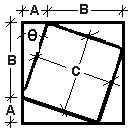| THERMO Spoken Here! ~ J. Pohl © | TOC NEXT ~ 4 |
Theorem of Pythagoras
 The Pythagorean Theorem applies to right triangles. It is an algebraic truth relating the lengths of sides and hypotenuse. The therorm has many proofs. Here we use the fact that the area of an outer square equals the sum of its interior areas. A basic idea,
The Pythagorean Theorem applies to right triangles. It is an algebraic truth relating the lengths of sides and hypotenuse. The therorm has many proofs. Here we use the fact that the area of an outer square equals the sum of its interior areas. A basic idea,
is used often in science and engineering. The image shows a square drawn inside of a larger square. The lengths A, B, C, and the acute angle θ are identified.
Prove the Theorem of Pythagoras.
♦ By the sketch, we see that the area of the circumscribed square equals the four areas of inscribed triangles plus the area of the inscribed square:
(A + B)2 = 4 (AB/2) + C2
By a previous proof we know: (A + B)2 = A2 + 2AB + B2. With this substitution we have:
A2 + 2AB + B2 = C2 + 4 (AB/2)
A touch of algebra and we have the Pythagorean Theorem:
A2 + B2 = C2. QED.
We can take this result a step further.
♦ First divide the theorem by C2, to obtain:
(A/C)2 + (B/C)2 = 1
Next realize for a right triangle, sin(θ) is defined as A/C and cos(θ) is defined as B/C. Make these substitutions into the theorem to obtain the famous formula:
sin2θ + cos2θ = 1 QED.
Theorem of Pythagoras

The Pythagorean Theorem, a statement of an algebraic truth regarding the sides and hypotenuse of right triangles, can be proved by use of geometry and the general truth:
"The whole equals the sum of its parts."
Presently not completed